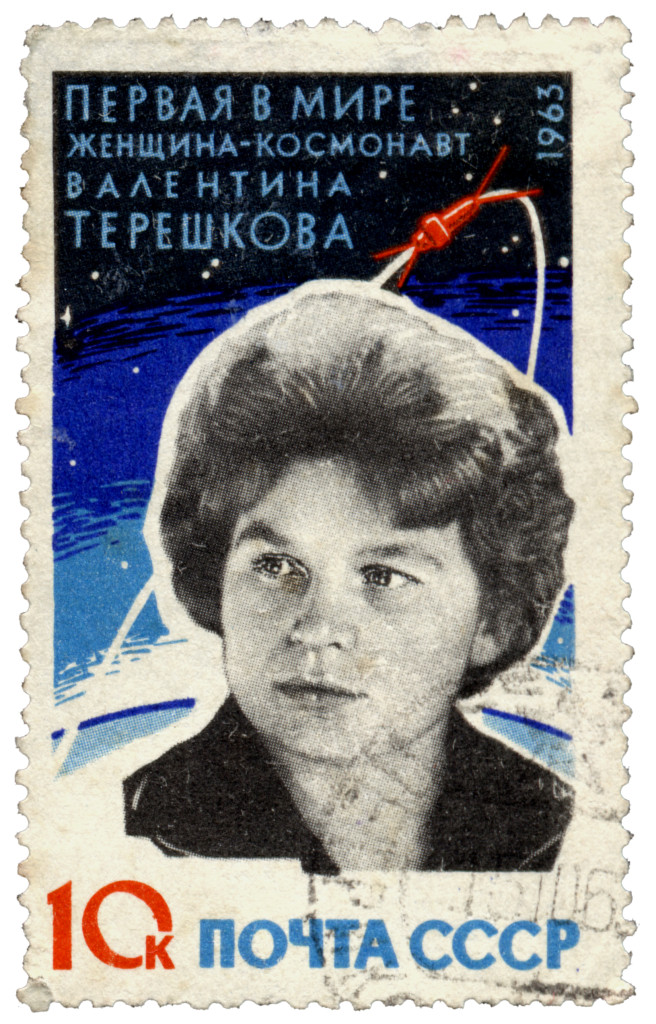
Ada Lovelace Day is four weeks away, so to celebrate, I’m doing a post each week to celebrate a major female contributor to the STEM fields. Today is Valentina Tereshkova, the first woman in space (and a lot more besides).
***
“I see the horizon. A light blue, a beautiful band. This is the Earth. How beautiful it is! All goes well.”
On June 16, 1963, at roughly 9:30am UTC, Valentina Tereshkova became the first woman in space. But the cosmonaut, whose callsign was “Chaika” (Чайка : “Seagull”), would not have an easy trip, during or after.
Spaceflight in the sixties was at no point a glamourous affair, but the crewed Vostok missions were rough by any standard. The capsule in which she spent roughly three days was a metal sphere two metres wide on the outside. Inside it was only big enough for one seated, space-suited cosmonaut, with a window above her head and another at her feet, equipped with a low-tech but clever design for manually orienting the spacecraft to the horizon for re-entry should the unfortunate need arise. The food — at least, she later claimed it was the food — made her vomit, and, she soon discovered, the flight control system had been misprogrammed to go up instead of down. After a speedy recalculation was relayed to correct her flight path during her forty-eight swings around the Earth, the eight-G (!) descent maneuver culminated in the use of an ejector seat at seven kilometers up. And that part had been planned: the Vostok, you see, couldn’t land, so its occupant was expected to find her own way down via parachute. Under heavy crosswinds, and no doubt exhausted by her ordeal, Tereshkova managed to guide her parachute just far enough not to land in a nearby body of water, bruising her face in the attempt to free herself from the parachute. When the Soviet authorities later arrived, to their surprise they found her eating dinner with the local villagers in the Altay region where she had landed. At least, that’s one version of events.

What’s most true about the story of Valentina Tereshkova is that the details are often hard to discern. Her involvement with the Vostok program was dreamed up by Sergey Korolyov, the architect of the Soviet rocketry program, who thought up the idea of putting the first woman in space after Yuri Gagarin’s historic flight. It would be a tribute to Soviet equality, a reflection of their ideals. This is not to minimize Tereshkova’s achievement — far from it — but from start to finish her story is muddled up with propaganda, and few details can be thought of as certain. Tereshkova’s daughter, for example, says her mother did not throw up in the capsule, and it wasn’t until 2007 that the detail about the flight computer misprogramming was even revealed. What is certain is that, from the moment she was selected, her story was manufactured around her.
A peasant from the village of Maslennikovo, and daughter of a tractor driver and a textile worker, Tereshkova dropped out of school early to finish her classes by correspondence, seemingly to work in a textile factory like her mother. In her late teens she became enamoured of skydiving, and made her first jump in 1959 at the age of 22. In 1961 she was the secretary at the local Young Communist League and shortly thereafter joined the party. Her father had died for the country in 1939, his tank set on fire with him inside. Everything about her was perfect. When it came down to a choice between Tereshkova and Valentina Ponomaryova, Nikita Kruschev himself made the decision. It may have been because she seemed more media friendly.
After the flight was more of the same: a celebration in Red Square, a favourable marriage to another cosmonaut, membership in the Supreme Soviet of the Soviet Union. As one BBC reporter put it, Tereshkova’s life was hijacked by the party. But until her flight, she’d had very little in the way of education, and she made good use of her newfound status to change that. By 1969, Tereshkova had graduated with honours from the Nicolai Zhukovsky Air Force Engineering Academy, and by 1977 she had earned a doctorate in engineering. After the collapse of the Soviet Union, she lost some of her clout, but also seemed to gain more freedoms. From 1994 she served as the head of the Russian Centre for International Scientific and Cultural Cooperation; she received an honourary doctorate from the University of Edinburgh in 2000; and she is now an elected official in the State Duma.
If you want to learn more about Tereshkova, there are a couple of notable biographies out, including Into that Silent Sea: Trailblazers of the Space Era, 1961-1965, as well as a number of articles from 2013, celebrating the 50th anniversary of her flight (especially in light of her now-released journal from the time, which is worth checking out as well).
Come back next Tuesday, as we continue our countdown to Ada Lovelace Day by talking about Maryam Mirzakhani, the first woman to win the Fields Medal.
***
Richard Ford Burley is a writer, library worker, and doctoral candidate in English at Boston College, where he’s studying remix culture and the processes that generate texts. In his spare time he writes about science, skepticism, and feminism (and famous women in STEM) here at This Week In Tomorrow.

One thought on “Valentina Tereshkova, First Woman in Space | Vol. 2 / No. 46.2”
Comments are closed.